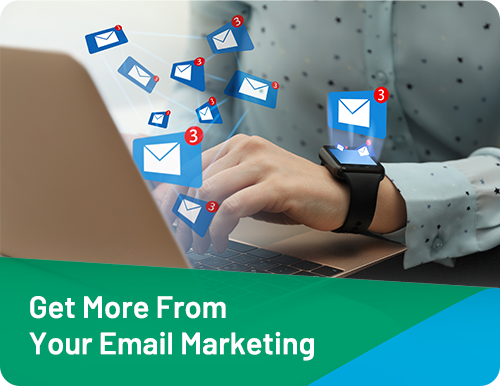The use of email marketing is on the rise, and there are a number of reasons why. Email marketing is a key part of any online marketing campaign, sending your message out to an established customer base and enticing them back to your site. Used well, email marketing can build brand awareness, develop customer loyalty and increase traffic and sales.
But how sure are you that your wonderful efforts are reaching your entire list? How do you know enough people are even reading your message? Here are some of the most common email marketing mistakes.
1. Bouncing
It is possible to maximise your campaign with fewer bounces (the email equivalent of ‘return-to-sender’). You may think there is no harm in sending out emails to a large, but inaccurate, list. After all, if the email address is closed, it just won’t go through; everyone else gets there’s, right?
Wrong.
Clean data is essential. Many Internet Service Providers (ISPs) will block some or all of your email campaigns if your bounce rate is too high.
Get into the routine of regularly removing bounced email addresses from your database. Provide a link for customers to update their details. Whatever you do, do not tolerate bad email data. It can damage your email campaign without you even being aware.
2. Spam
On average, 20% of legitimate emails are mistaken as spam (source: Return Path, ResenderStudy_101206 Research Brief 2006). When added to the average 5% of emails that bounce, you could be losing a quarter of your potential email readership even before people have opened their inboxes.
There are a number of factors involved with the identification of spam, but usually they revolve around authentication. For example; online email hosts, such as Yahoo Mail and Hotmail, use certain tools to authenticate all incoming mail. These include SenderID, SNDS, SPF Records and Domain Keys. For example, by tagging emails with SenderID, the Hotmail servers can clearly identify the source and thereby trusts the email is legitimate. Without a SenderID tag, Hotmail will assume the email is spam and either block it or push it into junk mail folders.
Online email accounts also build feedback on emails to determine reputation through their ’Junk’ or ‘Spam’ buttons in the toolbar. Many online users assume that by using these buttons, they are unsubscribing from the offending email list, but this is not the case. All these buttons do is raise a flag with the email ISP. If enough flags are raised, future emails from that address will become blocked as spam.
This means the onus is on the email marketer to take the reports of spam abuse seriously and remove those addresses from the list promptly. If you continue to send emails to people who identified your previous emails as spam, you are guaranteed to provoke enough red flags to get you blocked by the ISP.
For other Australian ISPs, such as BigPond, Optus, Primus and TPG, your reputation is influenced by the relationships you maintain with the providers. By taking notice of their particular guidelines and recommendations, and responding promptly to issues, you can avoid losing large chunks of your readership.
3. Subject line
We all receive a large number of emails every day. If you are like me, you don’t open them all. So what motivates a person to open your email?
The subject line should create curiosity, prompting to read more. The best way to approach this is by thinking ‘What’s in it for them?’.
Would you open an email merely marked ‘July Newsletter’? Would you feel motivated to click on an email marked ‘June Promotion’? What is in it for the reader?
Remember, the majority of people are not going to be interested taking time to read your marketing message. But they may, if they felt they would learn something useful in the process.
For example; instead of a subject line stating ‘New diet program available’ and thereby only eliciting the interest of the very small proportion of your readership, you could use a line like ‘How to feel younger, have more energy and look fantastic!’
The subject line needs to speak to a particular need or motivation in the reader, not merely state your own need – announcing a product.
4. Promotions and Advertising versus News and Information
When watching television, do you flick through the channels looking for the commercials? No. So why do some email marketers still assume that when customers go to their inbox, they will open emails that are clearly 100% adverts?
Television advertisers realised this a while ago, which is why so many programs incorporate marketing into their formats. ‘Better Homes and Gardens’ provides plenty of marketing opportunities within the program content, thereby achieving a higher viewer engagement than a standard commercial, when the audience is putting the kettle on.
Many email marketing campaigns rely on simply announcing a product or advertising a promotion. Occasional emails like this may be appropriate, but click through rates are low. A newsletter should contain news – or articles of interest at least. Again, the point is not what you want to tell the reader but what they want to read.
This is why the Netregistry newsletter uses detailed and specifically written articles instead of promotional items. More people open these emails and more people click through to the site. But articles work in other ways as well. Articles demonstrate that you are knowledgeable within your industry. This can create trust and authority amongst your customer-base. You can also gently prompt and educate readers about certain concepts, which may lead them to one of your products or services at a later date.
5. Analytics
Poor email results are bad enough, but the situation is even worse if you don’t know it is poor. Monitoring the statistics arising from your email campaign can help you to optimise and improve performance. How many emails were successfully delivered? How many emails were opened? How many people clicked through the email back to the site? All of these figures can – and should – be tracked.
If you use a dedicated email marketing service, these analytical results are generated automatically, providing all the information you need to optimise and refine your strategy.
6. Over or under
Nothing encourages readers to hit the ‘unsubscribe’ button faster than too many emails. If you send too many marketing emails, you risk pushing your audience, causing resentment. Over-saturation is very common and causes some readers to perceive this continual intrusion into their time as spam.
Alternatively, if your email campaign is irregular or rare, readers will not know what to expect. An unexpected email can sometimes be just as annoying.
Identify what the optimum regularity would be for your audience. In some industries, the audience may be more responsive to lots of online material. Others may have far less online time and therefore resent lots off unnecessary email.
Once you’ve identified this level (usually weekly or monthly), design a fixed schedule. By planning in advance and ensuring all stakeholders provide their necessary input to this schedule, you can ensure all emails go out on the same day every time.
7. Return on Investment
How do you track the return on investment of your email campaign? The physical act of sending out your message may not cost much at all, compared to postal campaigns. But any expense is a waste if there isn’t an appropriate return in business.
Sometimes this return is harder to track. For example, if your email marketing is run more as a brand awareness campaign, providing information and encouraging discussion, it is harder to relate the emails directly to sales on the site. These campaigns build up general business slowly over time, through association and word of mouth.
Alternatively, promotional campaigns have a far more obvious correlation between the email and the sale, tracked through the number of readers who clicked through the email and bought the item.
In these cases, it is important to gauge the item cost on sale against the number of click-throughs. For example; if you are marketing fridge/freezers and the email only prompts two sales, this may still adequately cover all the costs of the campaign. On the other hand, if you are marketing desk stationery and the campaign only results in additional sales of five packs of post-its and a stapler, you may have a problem.
The amount of click-through and conversion your campaign needs to achieve is in relation to the cost and margins of your products. Therefore, one product campaign with a 0.1% response against thousands of recipients can be far more successful than another with a 10% response against the same number. Don’t fall into the trap of thinking a response figure in single digits is a failure. It is all relative to the offer, the original goals of the campaign (branding or sales), and the price point available.
Conclusion
Email marketing is one of the most effective methods of attracting repeat business from your existing customer-base. But many businesses still treat email as a more trivial form of online marketing.
By planning your email campaign carefully, you can transform it into a highly effective conversation between you and your customers, building your brand and increasing traffic.
About the Author
Jonathan Crossfield is the Marketing Manager and head writer for Netregistry. He is a regular contributor on internet business to Nett Magazine.

